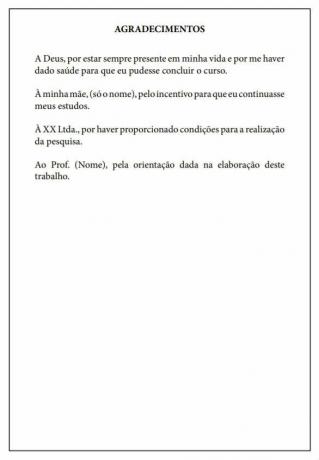For the preparation of academic papers, the standard used by the ABNT (Brazilian Association of Technical Standards) is 14724. This standard specifies, in detail, what structure and elements the work must contain.
Remembering that there are universities that have specific requirements and, in this case, the student must be informed about them.
Structure of academic work
The works must be structured as shown in the image below:

Cover
- Author's name;
- Title;
- City of the institution;
- Year of work.

Speed bump
The spine title must be centered and printed in the same direction as the author's name. Presented in accordance with ABNT NBR 12225, the spine must contain the following elements:
- Author's name;
- Title;
- Year of work.

cover sheet
The front should contain:
- Author's name;
- Title;
- Type of work (dissertation, TCC), objective (approval in subject, desired degree), name of institution, area of concentration;
- Advisor's name;
- City of the institution;
- Year of work.
The back should contain:
Cataloging-in-publication data as per the Anglo-American Cataloging Code.

Know more: ABNT cover sheet
Errata
Inserted after the cover sheet (mandatory element), the errata can be presented in a single sheet or enclosed with the work. Must contain:
- Author's name;
- Title;
- Type of work (dissertation, TCC), objective (approval in subject, desired degree), name of institution, area of concentration;
- City of the institution;
- Year of work;
- Erratum text.

approval sheet
- Author's name;
- Title;
- Type of work (dissertation, TCC), objective (approval in subject, desired degree), name of institution, area of concentration;
- Approval date;
- Name, title and signature of the elements that are part of the examining board and respective institutions.

See too: Approval sheet (ABNT standards)
Dedication
It must be inserted after the approval sheet, which is a mandatory element. The dedication has no title.

For more examples: TCC Dedication (ready sentences)
Thanks
It must be inserted after the dedication and its title must be centered.

If you want to know more: Acknowledgments from TCC (ready model and examples)
Title
The epigraph is a quotation related to the theme of the work. This sheet has no title and must be presented in accordance with ABNT NBR 10520, the standard referring to citations in works.

See too: Epigraph for TCC: famous phrases to use at work
Summary (abstract)
Prepared in accordance with ABNT NBR 6028, abstracts must contain objective, method, results and conclusions of the work.
Preferably in a single paragraph, and containing between 150 to 500 words, they should be written in the active voice and in the third person singular.
Abstracts are finalized by key words, which must be separated from each other by dots.


Lists of illustrations and tables
The titles of lists of illustrations and tables must be centered. The lists, presented in the order of the illustrations or tables inserted in the work, must contain:
- Designation of each item by specific name (followed by a dash);
- Title;
- Page number.


List of abbreviations and acronyms
The acronyms must be presented in alphabetical order, followed by the form in full. The title of the list of abbreviations and acronyms must be centered.

Symbol list
Presented by the order of symbols inserted in the work, followed by their meaning. The symbol list title must be centered.

summary
Prepared according to ABNT NBR 6027.
Pre-textual elements — cover sheet, approval sheet, abstracts in Portuguese and foreign languages — cannot be included in the summary.

To better understand: How to make a summary (ABNT rules)
textual elements
- Introduction: Part of the text in which the work's theme is defined;
- Development: Exposition of the subject covered in the work in detail;
- Conclusion: Closing of the text, which includes the results of the studies carried out throughout the work.

References
Prepared according to ABNT NBR 6023. References must contain:
- Authorship;
- Title;
- Edition;
- City of publication;
- Publishing company;
- Date.

Glossary
Must be presented in alphabetical order. Glossary title should be centered.

Appendix and Appendix
The appendix and the Annex must contain the word APPENDIX or ANNEX, followed by a capital letter (in alphabetical order), dash (—) and title. The title of the appendix and annex must be centered.

Index
Presented at the end of the work, the index must be prepared in accordance with ABNT NBR 6034 and its title must be centralized.
The index can be organized by authors, subjects, titles, among others.

formatting
paper and colors
- Black text (illustrations may have other colors);
- Paper, white or recycled, in A4 format;
- Printing: introduction, development and conclusion, as well as references, should preferably be printed on both sides.
margins
- Front of sheet:
- on the left side, at the top, should be 3 cm;
- on the right side, at the bottom, they should be 2 cm.
- Back of sheet:
- on the right side, at the top, should be 3 cm;
- on the left side, at the bottom, should be 2 cm.
Source
Size 12.
Exceptions:
Quotations longer than three lines, footnotes, pages, international cataloging-in-publication data, captions, and fonts—which should be smaller in size but consistent with each other.
Spacing
1.5 between the lines
Exceptions:
Quotes with more than three lines, footnotes, references, captions, type of work, objective, name of institution, area of concentration — which must be single-spaced.
Pages
The printed numbering must be entered from the job's introduction.
This means that cover and approval sheets, abstracts and summary must be counted, but must not contain the printout of the page.
The page should be inserted in the upper right corner. The last digit on the page must be 2 cm from the edge of the sheet.
In addition, you need to know that:
- Job numbering printed on the front of the sheet: only the front sheets should be counted;
-
Numbering of double-sided printed jobs:
- print pages should be inserted on the front of the sheet - in the upper right corner;
- printing pages should be inserted on the back of the sheet - in the upper left corner.
We are sure that these texts can help you even more:
- Research Project: how to do it?
- Scientific article: types of articles and structure in ABNT standards
- Step by step to make the best monograph (with valuable tips)
- TCC Presentation
- Direct and indirect citation
- Website quote: how to do it?
- Apud or citation citation: how to use correctly!
- Bibliography: what is it and how to do it?

